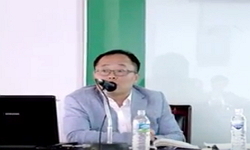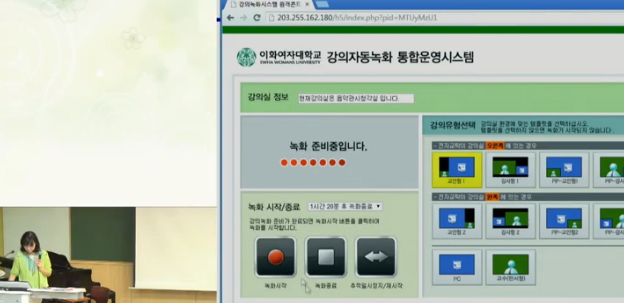This manuscript was written to watch the landscape concept and landscape literature of literary men belonged to Jangdong, Kim Moon, in 17th century ~ 18th century. To perform this purpose, among the persons who saw the sight of landscape a lot, retiri...
http://chineseinput.net/에서 pinyin(병음)방식으로 중국어를 변환할 수 있습니다.
변환된 중국어를 복사하여 사용하시면 됩니다.
- 中文 을 입력하시려면 zhongwen을 입력하시고 space를누르시면됩니다.
- 北京 을 입력하시려면 beijing을 입력하시고 space를 누르시면 됩니다.
17~18세기 장동 김문(壯洞 金門)의 산수문학 연구 = Study on the Landscape Literature of Jangdong Kim Moon, in 17C.~18C.
한글로보기https://www.riss.kr/link?id=T11436144
- 저자
-
발행사항
춘천 : 강원대학교, 2008
-
학위논문사항
학위논문(박사)-- 강원대학교 일반대학원 : 국어국문학과 2008. 8
-
발행연도
2008
-
작성언어
한국어
-
주제어
산수문학 ; 김수증 ; 김창협 ; 김창흡 ; 김원행 ; 노론 낙론계 ; 17세기 ; 은일 ; 18세기 ; landscape literature ; Jangdong Kim Moon ; 17C ; 18C ; Kim, Soo-jeung ; Kim, Chang-hyeob ; Kim, Chang-heub ; Kim, Won-hang ; retirement
-
발행국(도시)
강원특별자치도
-
기타서명
Study on the Landscape Literature of Jangdong Kim Moon, in 17C.~18C
-
형태사항
165 p.p. 26cm
-
일반주기명
지도교수:최웅
참고문헌 : p. - 소장기관
-
0
상세조회 -
0
다운로드
부가정보
다국어 초록 (Multilingual Abstract)
This manuscript was written to watch the landscape concept and landscape literature of literary men belonged to Jangdong, Kim Moon, in 17th century ~ 18th century. To perform this purpose, among the persons who saw the sight of landscape a lot, retiring to their hermitages in the nature, I set the persons who influenced on the era. With the related people to the above persons, called into question that study on the literature history in 17th century ~ 18th century was put value on the brothers, Kim Chang-hyeob and Kim Chang-heub, and set Kim Soo-jeung, who is their big uncle, and Kim Won-hang, who is their grandson, as the target of this study.
17th century is very unique for the ideology in the late Choseon dynasty. Each party was searching for different ideological alternative during the overcoming period after Japanese Invasion of Korea in 1592 and the Manchu war in 1636, and unavoidable conflict occurred during this period. This kind of conflict occurred from the inside of Seoin party. This ideological conflict was existed in Seoin party which took over the reins of government after King, Injo, dethroned the existed king. Seoin was finally divided into Handang, Sandang, Nohron and Sohron.
Nohron lead the political situation of Choseon in 17th century ~18th century. On the base of strong political power, ideological foundation such as Yeron and Uiriron was imbedded. With the base of scholastic influence, literary men of Nohron took over whole the culture system. Jangdong. As Kim Moon belonged to the core family of Nakron in Nohron, he showed political power. In understanding Chung dynasty, Anti-Chung ideology was expanded again that had been presented in 17th century. However, as people communicated with Chung more and more, and reigned over the nation as Kyeonghwa-sajok (a group who admires and learn Chung dynasty), they had a lot of chance to experience Chung's civilization. Upon this opportunity, they became more flexible for the ideology than Horon party which emphasized on spiritual enlightenment.
Kim, Soo-jeung tried to understand landscape as a practical factor, retiring to the hermitage at Gokwoongoogok. Also, he tried to apply the landscape to the paradigm of his recognition through a naming process and didn't consider the landscape as the target of a pleasure trip. Through his works, he configured simple life at the mountain to various long pieces of sequential poem. Also, as I consider his works when he got old, he expressed lamentation about life. At a late date, his works were changed into the memory for Kim, Sang-heon, and the subjects that he encouraged his children. Moreover, I can comprehend his works contained Neo-Confucianism through landscape.
Kim, Chang-hyeob left several pieces of writing about landscape. We can know he recognized landscape as a mean for training of his own character. So, he urged we should understand the principle of nature, not appreciate the outer figure of landscape. Landscape literature was written when he retired to the hermitage at Nong-am after Kisawhangook. He expressed his will to continue his hermitage through his admiration for some hermits. Also, through valuation of landscape, he selected what was good among the works that landscape was expressed to find Confucian value, and the profound secrets of Nature from the natural features of the landscape and season.
Kim, Chang-heub tried to appreciated landscape with intuitional attitude. Especially, he retired to the hermitage in Samboo Pond of Cheolwon area and Seorak Mountain. His will to continue his hermitage at the poor places was reflected on the poem that he wrote. On the other hand, he tried to follow Kim, Soo-jeung and Kim, Si-seub as role models of hermitage. He tried to apply the themes that he met with at his hermitry and realize what he went through the intuition for the substances.
Kim, Won-hang was a typical scholar who represented Nakron in Nohron from the brothers, Kim Chang-hyeob and Kim Chang-heub, to Lee, Jae. He was borne as a grandson of Kim, Chang-jib in 1702 (28th years of king, Sookjong) and concentrated learning, yielding imperial examination after going through Sinimwhangook. Although he was a Confucian, he tried to express any excitement while touring much landscape. Also, He emphasized on expressing any fundamental status rather than tones & rhythms from his poem. Moreover, he summarized his ideology as "For the life at the forest"," Admiration for saint" and "Theme for Taoism". Even though he song landscape, and natural features of the landscape and season, he talked about the hidden means behind those rather than song landscape itself.
In the landscape literature, the historical mean of literature lies on the next factors; (1) It was embedded as literature works, typical Confucian hermit through affirmative expression for the origin (2) Landscape literature was designed to be prosperous through perfect description for the real scenery. (3) The natural features of the landscape and season were considered as the order system of Taoism.
국문 초록 (Abstract)
본고는 17~18세기 장동 김문의 문인들의 산수관과 산수문학의 특성을 살피는 데에 목적을 두었다. 이를 수행하기 위해 은일을 통해 산수 경물을 접할 기회가 많았던 인물들 중 당대에 영향...
본고는 17~18세기 장동 김문의 문인들의 산수관과 산수문학의 특성을 살피는 데에 목적을 두었다. 이를 수행하기 위해 은일을 통해 산수 경물을 접할 기회가 많았던 인물들 중 당대에 영향력을 발휘했던 인물을 연구 대상으로 설정하였다. 그동안 17?18세기 문학사 연구가 김창협?김창흡 형제에 치중하였던 것에 문제를 제기하고 이들과 영향관계에 놓인 인물로 그들의 백부 김수증과 손자 김원행을 아울러 연구 대상으로 설정하였다.
조선 후기 사상계 속에서 17세기는 매우 특별한 위치를 점하고 있다. 임진왜란과 병자호란 이후 전후 극복 과정에서 당파들은 각기 다른 사상적 대안을 모색하고자 했고, 이 과정에서 불가피한 충돌이 발생하였다. 이러한 사상적 대립은 인조반정 이후 정권을 담당하던 서인 당파 안에서도 존재하였다. 서인은 한당과 산당으로, 노론과 소론으로 분열?대립하는 양상을 보였다.
노론은 17?18세기에 조선의 정국을 주도하였다. 막강한 정치력의 저변에는 예론(禮論)과 의리론(義理論)이라는 사상적 토대가 마련되어 있었다. 학문적인 영향력을 바탕으로 하여 노론계 문인들은 문화 전반을 주도하였다. 장동 김문은 노론 낙론계의 핵심 가문으로 정치적인 영향력을 발휘하였다. 청나라를 인식하는 데에 있어서 17세기 초반에 보이던 반청의식이 팽배하였으나, 점차 청과의 교류가 잦아지고 경화사족으로 군림하면서 자연스럽게 청의 문물을 접할 기회가 늘었다. 이를 계기로 하여 도통 의식을 강조하던 호론 계열보다 사상적인 유연성을 보이기 시작하였다.
김수증은 곡운구곡의 은거를 실행하며 산수를 보다 실천적으로 인식하려 하였다. 산수를 단순히 유람의 대상으로 여기지 않고 명명(命名)의 과정을 통해 인식의 틀로 가져오려고 하였다. 그는 작품을 통해 산촌에서의 소박한 삶을 여러 편의 장편 연작시로 형상화 하였다. 또 주로 노년에 지은 작품들이 많으므로 삶에 대한 자탄을 노정하였는데, 이들 작품은 김상헌에 대한 회고와 자제들에게 권면하는 주제로 전환되었다. 또 산수를 통해 주자학적 이상향을 추구하려는 작품이 뚜렷한 한 경향으로 파악할 수 있다.
김창협은 산수에 대한 글을 여러 편 남겼다. 기문과 편지글에 산수를 성정 도야의 수단으로 인식했다. 따라서 명성에 현혹되어 산수의 겉모습만 감상하는 것이 아니라 그 속에 내재된 자연의 이치를 파악해야 한다고 하였다. 산수 문학은 주로 기사환국 이후 농암에 은거하면서 창작되었다. 자신의 은거를 지속하겠다는 의지를 은자의 삶에 대한 예찬으로 표현하였다. 또 산수 품평을 통해 산수의 우열을 가려 그 속에서 유학적인 가치를 찾고자 하였다. 이를 통해 산수 경물 속에서 천기를 발견하고자 하였다.
김창흡은 산수를 관물적 태도로 감상하려고 하였다. 특히 김창흡은 철원 삼부연이나 설악산 등지에서 은거를 실행하였다. 문학 작품에서는 이와 같이 궁벽한 곳으로 은거지를 옮겨가며 은일을 지속하고자 했던 의지가 시에 표출되었다. 한편 백부인 김수증, 김시습 등의 인물을 은자의 전형으로 설정하여 이들의 행적을 따르고자 하였다. 한편, 은거의 일상에서 부딪치는 소재들을 시에 적극적으로 개입시키고 사물에 대한 관조를 통해 깨달음을 얻고자 하였다.
김원행은 김창협, 김창흡 형제에서 이재(李縡)로 이어지는 노론 낙론계를 대표하는 학자이다. 그는 1702년(숙종 28) 김창집의 손자로 태어났으나 “신임환국”을 겪으면서 과거를 포기하고 고향에서 학문에 집중하였다. 김원행은 비록 유학자이지만, 산수 사이를 출입하면서 그곳에서 생기는 흥취를 표현하는 일을 긍정하고 있다. 또 시에서 음률 보다는 기격의 분출을 중시하였다. 그리고 김원행은 시 속에서 “산림으로서의 삶 지향”, “선현에 대한 흠모”, “도학적 주제”를 전달하는 등의 주제로 정리하였다. 산수와 경물을 읊고 있으나 경물 자체를 읊기 보다는 그 속에 숨어 있는 의미를 찾아 이야기하고 있다.
이들 산수문학은 1) 출처에 대한 적극적인 표명을 통해 유학자적 은자의 전형을 마련하여 문학 작품으로 구체화한 점, 2) 실경에 대한 핍진한 묘사를 통해 산수 문학의 발흥을 꾀한 점, 3) 산수 자연을 도학적인 질서 체계로 인식했다는 점에서 그 문학사적 의의를 찾을 수 있다.
목차 (Table of Contents)
- Ⅰ. 서 론 8
- 1. 연구 목적 8
- 2. 연구사 10
- 3. 연구 방법 13
- Ⅰ. 서 론 8
- 1. 연구 목적 8
- 2. 연구사 10
- 3. 연구 방법 13
- Ⅱ. 장동 김문(壯洞 金門)의 학맥 형성 과정과 학문적 경향 20
- 1. 노론계 문인의 학맥 형성 과정 20
- 1) 17~18세기의 시대적 의미 20
- 2) 노론계 문인과 김시습(金時習) 포양 사업 24
- 3) 김상헌(金尙憲)의 위상과 장동 김문의 형성 28
- 2. 노론계 문인의 학문적 경향 34
- 1) 주자(朱子)의 무이구곡 수용 35
- 2) 소옹(邵雍)의 상수학풍 수용 39
- 3) 의리지향적 출처관 41
- Ⅲ. 김수증(金壽增)의 산수관과 문학 세계 46
- 1. 산수관 46
- 2. 문학 세계 58
- 1) 산촌의 삶 구가(謳歌) 58
- 2) 삶에 대한 자탄 66
- 3) 주자학적 이상향 추구 70
- Ⅳ. 김창협(金昌協)의 산수관과 문학 세계 79
- 1. 산수관 79
- 2. 문학 세계 87
- 1) 은자의 삶 예찬 87
- 2) 산수에 대한 품평 95
- 3) 천기의 발견 100
- Ⅴ. 김창흡(金昌翕)의 산수관과 문학 세계 107
- 1. 산수관 107
- 2. 문학 세계 114
- 1) 절속의 의지 표현 114
- 2) 은자의 전형 제시 120
- 3) 관조적 세계의 표출 125
- Ⅵ. 김원행(金元行)의 산수관과 문학 세계 128
- 1. 산수관 128
- 2. 문학 세계 132
- 1) 산림으로서의 삶 지향 132
- 2) 선현에 대한 흠모 136
- 3) 도학적 주제 전달 142
- Ⅶ. 결 론 147
- 참고문헌 153
- Abstract 163












